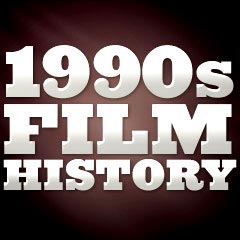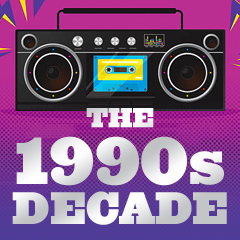|
Actors Turned Directors:
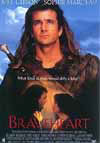 Three
actors/directors received numerous awards for their Best Pictures. Kevin
Costner's directorial debut film - the Native-American epic Dances
With Wolves (1990) - was honored with twelve nominations and seven
wins including Best Picture and Best Director. Clint Eastwood won accolades
with the elegaic, revisionist western Unforgiven
(1992), another Western genre film to win Best Picture (and Best
Director). [Producer Eastwood directed and starred in the revisionist,
deglamourized western as a retired gunslinger forced to return to killing.] Three
actors/directors received numerous awards for their Best Pictures. Kevin
Costner's directorial debut film - the Native-American epic Dances
With Wolves (1990) - was honored with twelve nominations and seven
wins including Best Picture and Best Director. Clint Eastwood won accolades
with the elegaic, revisionist western Unforgiven
(1992), another Western genre film to win Best Picture (and Best
Director). [Producer Eastwood directed and starred in the revisionist,
deglamourized western as a retired gunslinger forced to return to killing.]
And producer/actor/director Mel Gibson's historical Scottish
epic Braveheart (1995) also won the Best Picture and Best Director
honors, among others. Gibson starred as the Scottish hero William Wallace,
and Patrick McGoohan played the role of Edward Longshanks. Robert Redford
directed his third film, A River Runs Through It (1992), a beautifully-evocative
film made on location in Montana about two brothers of the MacLean family
(headed by minister Tom Skerritt) who followed different paths: older
serious son Craig Sheffer and impetuous, wild gambling younger son Brad
Pitt. He also directed Quiz Show (1993), about the TV game show
"Twenty-One" cheating scandal involving Charles Van Doren (Ralph
Fiennes) and unfairly beaten Herbie Stemple (John Turturro).
Rob Reiner first directed the overly-emoted A Few Good
Men (1992) - with Guantanamo Bay, Cuba as the scene of a crime in
the military, followed by a courtroom drama pitting Navy lawyer Tom Cruise
against the hystrionics of higher-up Jack Nicholson. Reiner also directed
the romantic comedy The American President (1995) which starred
Michael Douglas as the President and Annette Bening as a lobbyist who
fall in love with each other. [Its appearance seemed to inspire the creation
of the popular TV hit The West Wing.]
Maverick Writer/Director Quentin Tarantino:
 Violence
accompanied a number of films, including those of emerging maverick writer/director
Quentin Tarantino, a self-promoting videostore clerk who demonstrated
his exciting, self-taught, original filmmaking genius (with generous helpings
of violence, sex, and profanity) in his first film Reservoir Dogs (1992).
The cult hit broke many of the rules of conventional crime films in its
tale of a group of color-named criminals whose jewelry heist went awry.
It began with a deconstruction of Madonna's 'Like A Virgin' and even featured
director Tarantino as Mr. Brown. Violence
accompanied a number of films, including those of emerging maverick writer/director
Quentin Tarantino, a self-promoting videostore clerk who demonstrated
his exciting, self-taught, original filmmaking genius (with generous helpings
of violence, sex, and profanity) in his first film Reservoir Dogs (1992).
The cult hit broke many of the rules of conventional crime films in its
tale of a group of color-named criminals whose jewelry heist went awry.
It began with a deconstruction of Madonna's 'Like A Virgin' and even featured
director Tarantino as Mr. Brown.
Tarantino served as co-screenwriter (with Roger Avary)
and director of an acclaimed (Best Screenplay-winning) follow-up, low-budget
independent film Pulp Fiction (1994). The Cannes Film Festival
Palme d'Or winner and seven-time Academy Award nominee was an ultra-violent,
intermingling, non-linear trio of criminal life stories intertwined in
a sleazy Los Angeles (involving hitmen, a crime boss' overdosing wife
played by Uma Thurman, and a boxer - Bruce Willis) that gave John Travolta
a super-star comeback (famed as a hitman for talking about what the French
call fast-food Big Macs). It began with and returned to a scene of Pumpkin
and Honey Bunny holding up a restaurant.
Director/screenwriter Tarantino also followed up with
a more mature character study in his leisurely crime thriller Jackie
Brown (1997) with ex-blaxploitation 70s star Pam Grier in a stand-out
role as an ex-con.
Films About Hollywood and Film-Making (Before the 90s):
Before the decade of the 90s, a number of films looked
at the dark underbelly of the business of making illusions (movies) in
the Hollywood film industry, and often cautioned against its beguiling
ways and problems. Many were inspired directly or indirectly by Billy
Wilder's caustic and corrosive black comedy, Sunset
Boulevard (1950) about an abandoned silent era screen actress:
- The Bad and the Beautiful (1952)
was a cynical look at the hypocrisies, exploitations and deceits of
Hollywood's film industry and the studio system
- Singin' in the Rain (1952)
reflected the crisis faced by many in Hollywood's film industry during
the transition to sound from the silent era
- A Star is Born (1954)
- Will Success Spoil Rock Hunter? (1957)
from director Frank Tashlin, was a frenetic comedy with Jayne Mansfield
and Tony Randall, including media satire about the excesses of 50's
American pop-culture (including the movies, TV, and advertising)
- Whatever Happened to Baby Jane?
(1962) portrayed the real-life animosity
heightening the tension between stars Crawford and Davis, who starred
as rival ex-'30s movie stars
- Francois Truffaut's comedy-drama Day For Night (1973)
featured Truffaut as director Ferrand shooting a fictional film titled
May I Introduce Pamela, while observing and celebrating the art
of movie-making
- director Blake Edwards satire, S.O.B. (1981)
starred Richard Mulligan as a director (the director's alter ego) healing
from a nervous breakdown and salvaging his career by converting his
latest G-rated flop into an R-rated blockbuster - notorious for Julie
Andrews' appearance topless
- the documentary Burden of Dreams (1982) told
about the 'making of a movie' - the chaotic and dangerous production
of Werner Herzog's epic Fitzcarraldo (1982) shot mostly on location
in the rain forests of South America
Films About Hollywood and Film-Making In the 90s Decade:
A flood of films in the 90s looked at the often-times
vain, difficult and failed business of making films as their prime subject
matter:
- Christopher Guest's The Big Picture (1989) looked
at the Hollywood film industry through the perspective of a young aspiring
wannabe filmmaker Nick Chapman (Kevin Bacon) who won a student film
contest with his flick First Date - and was immediately signed
with high-strung agent Neil Sussman (Martin Short) and a deal with sleazy
studio head Allen Habel (J.T. Walsh)
- Giuseppe Tornatore's heartwarming Cinema Paradiso
(1989) celebrated the magic and love of film through the eyes of
a film-maker recalling his childhood and his village's small theatre
and projectionist - with its famous scene of a montage of censored film
kisses
- Clint Eastwood's White Hunter Black Heart (1990)
was a thinly fictionalized account of a legendary movie director (John
Huston) as he filmed in Africa The African Queen
(1951) - the screen version of C. S. Forester's novel The
African Queen written by James Agee (and Peter Viertel)
 Hearts
of Darkness: A Filmmaker's Apocalypse (1991)
chronicled the chaos and difficulties on the set of the production of
Francis Ford Coppola's Apocalypse Now (1979) Hearts
of Darkness: A Filmmaker's Apocalypse (1991)
chronicled the chaos and difficulties on the set of the production of
Francis Ford Coppola's Apocalypse Now (1979)- the Coen Brothers' original black comedy Barton
Fink (1991), with the tagline: "Between Heaven and Hell There's
Always Hollywood!" captured the difficulties experienced by a Clifford
Odets-like left-wing New York intellectual playwright named Barton Fink
(John Turturro) - with writer's block in a fleabag hotel - in Hollywood
in the early 1940s where he was commissioned by Capitol Pictures and
its studio head Jack Lipnick (Michael Lerner) with a strange, lucrative
assignment -- to write a Wallace Beery wrestling picture; it was the
first film to sweep three major awards at the Cannes Film Festival:
it received honors including the Palme d'Or, the director's prize (Joel
Coen), and Best Actor (Turturro)
- Robert Altman's satirical The Player (1992), with
an all-star cast and numerous subplots about Hollywood's dark wheeling
and dealing involving power, greed, and murder - told about an ambitious
studio executive blackmailed by a screenplay writer whose script was
rejected
- Joe Dante's overlooked Matinee (1993) was a
disguised portrait of innovative exploitation film-maker William Castle
(responsible for such cinematic horror gimmicks as Emergo and Percepto)
in the person of small-time showman and huckster film producer Lawrence
Woolsey (John Goodman), and set during the time of the Cuban Missile
Crisis
- Ed Wood (1994) was a biopic-movie devoted to the life of one
of the worst film directors ever - Edward D. Wood, Jr. (Johnny Depp)
- the maker of schlock cult movies, such as Glen or Glenda? (1953)
and Plan 9 from Outer Space (1956)
- writer/first-time director George Huang's black comedy
Swimming with Sharks (1994) starred Kevin Spacey as hateful,
abusive and caustic Keystone Pictures producer/studio executive Buddy
Ackerman and Frank Whaley as his young, naive, and maltreated Hollywood
studio assistant (Frank Whaley) - a recent film grad student who ultimately
sought revenge
- Barry Sonnenfeld's satirical mobster black comedy Get
Shorty (1995), based
on Elmore Leonard's 1990 novel, was about the intermixing of crime and
Hollywood; it told about a small-time, Miami mob loan shark/debt collector
(John Travolta) sent to Hollywood who ended up in the movie business;
with stars Rene Russo, Danny DeVito as Martin Weir, and Gene Hackman
as low-budget horror movie producer Harry Zimm
- real-life writer/director Tom DiCillo's Living in
Oblivion (1995) was a "movie-within-a-movie" about the problems inherent in
low-budget, independent film-making by a harried film director (Steve
Buscemi)
- screenwriter and producer Joe Eszterhas' An Alan
Smithee Film: Burn Hollywood Burn (1997) had the tagline: "The
movie Hollywood doesn't want you to see"; it starred Eric Idle
as filmmaker Alan Smithee - a well-known pseudonym for a director who
disowns his own film - as a director of a big-budget blockbuster produced
by Ryan O'Neal that he wanted to disown; ironically, the real director,
Arthur Hiller, also wanted his name removed from the actual credits
of the film
- Paul Thomas Anderson's Boogie Nights (1997) examined late 70's and 80's California hardcore pornographic film-making
- Frank Oz's Bowfinger (1999) from a script by
Steve Martin, told about the making of an awful sci-fi alien film (Chubby
Rain) by Ed Wood-like Bobby Bowfinger (Martin) - a desperate producer/director
who filmed uncooperative action megastar Kit Ramsey (Eddie Murphy) as
the star of his film - without the actor's consent
- the documentary The Kid Stays in the Picture (2002)
told the story of legendary Paramount producer Robert Evans - "the
man who seduced Hollywood"; it was based on Evans' own autobiography
of the same name and the film was narrated by him
- the documentary Lost in La
Mancha (2002) chronicled the failed attempt in the year 2000 of
maverick film-maker Terry Gilliam to make (or 'un-make') a film out
of a script titled The Man Who Killed Don Quixote (an adaptation
of the original novel)
- director Martin Scorsese's The Aviator (2004)
evoked the glamorous Golden Age of Hollywood with its biopic look at
the early years of legendary director and aviator Howard Hughes (Leonardo
DiCaprio)
Political-Thriller Films:
 An
era of suspenseful, post-Cold War adventure spy films was launched in
the 90s, all based on Tom Clancy's best-selling "Jack Ryan" techno-thriller
novels. The first in the Paramount series was directed by John McTiernan,
and the rest of the trilogy by Phillip Noyce: An
era of suspenseful, post-Cold War adventure spy films was launched in
the 90s, all based on Tom Clancy's best-selling "Jack Ryan" techno-thriller
novels. The first in the Paramount series was directed by John McTiernan,
and the rest of the trilogy by Phillip Noyce:
Ford was also featured in Alan Pakula's gripping who-dun-it
thriller Presumed Innocent (1990) as an adulterous prosecuting
attorney who investigates the murder of a seductive lawyer (Greta Scacchi)
and becomes a suspect himself. Sylvester Stallone made a comeback in the
non-stop, relentlessly-exciting Cliffhanger (1993). Tony Scott's
tense military thriller Crimson Tide (1995) extended the trend
of Hollywood's production of political-military pictures. And In the
Line of Fire (1993) was the story of a government agent (Clint Eastwood)
haunted by his past, because of failing to protect Kennedy in 1963, and
now called upon to protect the present-day President from psychotic killer
John Malkovich. Air Force One (1997) told of threats against President
Harrison Ford aboard his airplane.
John Grisham's Film Adaptations:
Adaptations of John Grisham's best-sellers, many of which
were legal thrillers set in the South, also did well at the box-office:
 Sydney
Pollack's crime thriller The Firm (1993), with Tom Cruise as
a young, Mafia-duped Harvard Law School graduate Sydney
Pollack's crime thriller The Firm (1993), with Tom Cruise as
a young, Mafia-duped Harvard Law School graduate- writer/director Alan Pakula's conspiracy thriller The
Pelican Brief (1993) featured Julia Roberts as a clever and endangered
Tulane University law student, and Denzel Washington as her supportive
crusading investigative reporter
- director Joel Schumacher's The Client (1994),
starring Oscar-nominated Susan Sarandon as a recovering alcoholic lawyer
who must protect the safety of her Mob-threatened young client (Brad
Renfro)
- James Foley's courtroom drama and character study The
Chamber (1996), with Chris O'Donnell as a naive Chicago defense
attorney involved in an appeals case with a racist, Mississippi KKK
member and death-row inmate (Gene Hackman)
- Joel Schumacher's racially-charged A Time to Kill
(1996), starring Samuel L. Jackson as a vengeful Southern black
father defended by novice Southern lawyer Matthew McConaughey and his
legal aide-clerk Sandra Bullock in a small Mississippi town
- scriptwriter/director Francis Ford Coppola's The
Rainmaker (1997), a David vs. Goliath tale with Matt Damon as a
naive young Memphis law school graduate battling a group of corrupt
insurance company lawyers headed by Jon Voight
Nineties Neo-Noirs:
Belfast-born actor/director Kenneth Branagh directed his
second film (following his revisionist rendering and scripting of Shakespeare's
Henry V (1989)), the intelligent and suspenseful noir thriller
Dead Again (1991). In the film, Branagh starred as a cynical L.A.
private detective who investigated a twisting cycle of murder involving
a mysterious amnesia victim (Emma Thompson, Branagh's real-life wife at
the time).
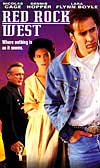 A
master of modern noir, writer-director John Dahl contributed three
great stylish neo-noirs in the decade: A
master of modern noir, writer-director John Dahl contributed three
great stylish neo-noirs in the decade:
- Kill Me Again (1989), Dahl's film debut, with
Joanne Whalley-Kilmer as a ruthless, deceptive woman involved in an
intricate plot of double-cross between psychotic mobster Michael Madsen
and private eye Val Kilmer hired to fake her own death
- Red Rock West (1993), a great sleeper film,
with Nicolas Cage as a loser-drifter caught in a twisting murder plot
and a case of mistaken identity in an isolated Wyoming town, with a
psycho contract killer (Dennis Hopper) and the intended femme fatale
victim (Lara Flynn Boyle)
- John Dahl's contemporary film
noir The Last Seduction (1994), starred Linda Fiorentino in an
outstanding, single-minded role as a scheming, amoral, sexy and lethal
femme fatale; the film was broadcast on HBO cable TV before being
released in theaters - thereby eliminating and invalidating its eligibility
for an Oscar nomination (Best Actress or Best Picture)
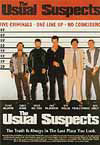 Gus
Van Sant's dark comedy-satire To Die For (1995) featured Nicole
Kidman as obsessed and determined cable-TV weather reporter Suzanne Stone
who sought to have Joaquin Phoenix kill her obstructive husband Matt Dillon.
Bryan Singer's mystery/crime thriller The Usual Suspects (1995), screened at Sundance, had a complicated screenplay and a surprise ending. It starred Kevin Spacey
in his first Oscar-winning performance of the decade as a petty crook
- and the all-knowing, black-hearted villainous crime lord Keyser Soze.
Spacey also appeared in British theater director Sam Mendes' motion-picture
directorial debut picture - DreamWorks' brightly-colored black comedy
about an unhappily-married couple in suburbia, American Beauty (1999)
and became a multiple Oscar winner for his role as head of the dysfunctional
family. While his real estate-selling wife (Annette Bening) was having
an affair, he was obsessing over his daughter's cheerleader friend (Mena
Suvari). Gus
Van Sant's dark comedy-satire To Die For (1995) featured Nicole
Kidman as obsessed and determined cable-TV weather reporter Suzanne Stone
who sought to have Joaquin Phoenix kill her obstructive husband Matt Dillon.
Bryan Singer's mystery/crime thriller The Usual Suspects (1995), screened at Sundance, had a complicated screenplay and a surprise ending. It starred Kevin Spacey
in his first Oscar-winning performance of the decade as a petty crook
- and the all-knowing, black-hearted villainous crime lord Keyser Soze.
Spacey also appeared in British theater director Sam Mendes' motion-picture
directorial debut picture - DreamWorks' brightly-colored black comedy
about an unhappily-married couple in suburbia, American Beauty (1999)
and became a multiple Oscar winner for his role as head of the dysfunctional
family. While his real estate-selling wife (Annette Bening) was having
an affair, he was obsessing over his daughter's cheerleader friend (Mena
Suvari).
 Curtis
Hanson, who had earlier directed the thriller The Hand That Rocks the
Cradle (1992), directed the much-acclaimed, modern film noir and police
drama L.A. Confidential (1997), set in early 50s Los Angeles and
adapted from James Ellroy's crime story. A shooting at an all-night diner
set the stage for the film. Two of its Aussie stars, Russell Crowe and
Guy Pearce, became more familiar to movie-goers since 1997, as has character
actor Kevin Spacey (who portrayed a detective who also served as a TV
consultant). The film received nine nominations and two Oscars (Best Adapted
Screenplay and Best Supporting Actress for Kim Basinger). Curtis
Hanson, who had earlier directed the thriller The Hand That Rocks the
Cradle (1992), directed the much-acclaimed, modern film noir and police
drama L.A. Confidential (1997), set in early 50s Los Angeles and
adapted from James Ellroy's crime story. A shooting at an all-night diner
set the stage for the film. Two of its Aussie stars, Russell Crowe and
Guy Pearce, became more familiar to movie-goers since 1997, as has character
actor Kevin Spacey (who portrayed a detective who also served as a TV
consultant). The film received nine nominations and two Oscars (Best Adapted
Screenplay and Best Supporting Actress for Kim Basinger).
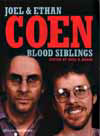 The
anarchic Coen brothers continued to make twisted but very influential
independent films in many genre areas, including the gangster film Miller's
Crossing (1990), Barton Fink (1991), The
Hudsucker Proxy (1994), and the Oscar-winning black
comedy Fargo
(1996) - their most conventional film to date, about
a kidnapping-blackmail scheme that went awry. It had a twisting
plot and featured Best Actress-winning Frances McDormand as
a determined, pregnant Minnesota police The
anarchic Coen brothers continued to make twisted but very influential
independent films in many genre areas, including the gangster film Miller's
Crossing (1990), Barton Fink (1991), The
Hudsucker Proxy (1994), and the Oscar-winning black
comedy Fargo
(1996) - their most conventional film to date, about
a kidnapping-blackmail scheme that went awry. It had a twisting
plot and featured Best Actress-winning Frances McDormand as
a determined, pregnant Minnesota police  sheriff investigating
a triple-murder, and William H. Macy as the perpetrator -
a desperate used car salesman. sheriff investigating
a triple-murder, and William H. Macy as the perpetrator -
a desperate used car salesman.
The pair also directed the
quirky and convoluted mystery-crime/thriller The
Big Lebowski (1998) with Jeff Bridges as a stoned, bowling-loving
'Dude' in early 1990s LA caught in a complex case of mistaken identity,
kidnapping, extortion, and ransom. Since its release, it has
become one of the most revered films of the Coens - a cult
classic of absurdist pop cultural elements (in episodic vignettes)
all thrown together as a shaggy dog tale, including a pissed-on
rug, nihilism, strange performance art, White Russians and doobies, Hollywood
porn, Bob Dylan, and much more. It was reminiscent of writer
Raymond Chandler's writings that backed the film noir The
Big Sleep (1946).
The Dying Musical Genre:
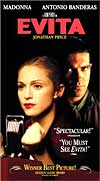 There
was very little evidence of films from the musical genre beyond just a
few examples: the first major Hollywood musical in almost a decade and
a half was director Alan Parker's Evita (1996) - based on the stage
musical by Andrew Lloyd Webber and Tim Rice and starring an impressive
Madonna in the lead role as Argentina's first lady Eva Peron. The film
won Golden Globe Awards for Best Comedy/Musical and Best Actress, and
one of its songs, You Must Love Me won the Academy Award for Best
Original Song. A second example was Woody Allen's revival of the musical-romantic
comedy - Everyone Says I Love You (1996). There
was very little evidence of films from the musical genre beyond just a
few examples: the first major Hollywood musical in almost a decade and
a half was director Alan Parker's Evita (1996) - based on the stage
musical by Andrew Lloyd Webber and Tim Rice and starring an impressive
Madonna in the lead role as Argentina's first lady Eva Peron. The film
won Golden Globe Awards for Best Comedy/Musical and Best Actress, and
one of its songs, You Must Love Me won the Academy Award for Best
Original Song. A second example was Woody Allen's revival of the musical-romantic
comedy - Everyone Says I Love You (1996).
Some of the best musicals of the decade were animated
features (see more below), jump-started by Disney's The Little Mermaid
(1989). Some examples included: Beauty and The Beast (1991),
the only musical nominated for Best Picture for many years and the first
animated Best Picture nominee in Academy history, Aladdin (1992),
The Lion King (1994), Pocahontas (1995), The Hunchback
of Notre Dame (1996), Anastasia (1997) - the first animated
feature film from 20th Century Fox, and The Prince of Egypt (1998)
- DreamWorks' first animated feature film.
Comedies:
 Horror
king Wes Craven made an unpredicted comeback with Scream (1996),
a well-made, intelligent version (from a witty script by Kevin Williamson)
of the schlocky slasher films of the 70s and 80s. It was both a post-modern
comedy and horror film of the 'stalk' and 'slash' variety, with star Drew
Barrymore as the first to be stalked by a 'ghost-faced' serial killer. Craven reprised
the successful film with two sequels in the decade, all with bright young
female star Neve Campbell in the lead role: Horror
king Wes Craven made an unpredicted comeback with Scream (1996),
a well-made, intelligent version (from a witty script by Kevin Williamson)
of the schlocky slasher films of the 70s and 80s. It was both a post-modern
comedy and horror film of the 'stalk' and 'slash' variety, with star Drew
Barrymore as the first to be stalked by a 'ghost-faced' serial killer. Craven reprised
the successful film with two sequels in the decade, all with bright young
female star Neve Campbell in the lead role:
- Scream 2 (1997)
- Scream 3 (2000)
All three low-budget horror films helped to generate cash
for Miramax' subsidiary, Dimension Films.
Mike Myers (as Wayne) and Dana Carvey (as Garth), originally
buddies in a Saturday Night Live skit, were particularly memorable
("Ex-squeeze me?" and "Schwing!") in the feature-length
anarchic comedy Wayne's World (1992), followed by a similar sequel
the next year. Myers would also play the dual lead role (as both a hip
fashion photographer in swingin' 60s London, and as a crime-fighter) in
the first of a series of James Bond parodies - Austin Powers: International
Man of Mystery (1997).
In Kindergarten Cop (1990), police officer Arnold
Schwarzenegger went back to school. Sister Act (1992) starred Whoopi
Goldberg as a singer who went into hiding for protection, and became a
nun. Desperate divorcee Daniel Hillard (Robin Williams) cross-dressed
to be a nanny in order to see his kids in Mrs. Doubtfire (1993).
In the screwball comedy Bean (1997), Rowan Atkinson (in the title
role that he originated on TV) was supposed to be an art expert looking
after Whistler's Mother. The Farrelly Brothers' tasteless and raunchy
romantic comedy There's Something About Mary (1998) included Ben
Stiller experiencing a problem with his 'frank and beans' on prom night,
and Cameron Diaz as his date - who also discovered a new form of hair
gel. In Harold Ramis' crime comedy Analyze This (1999), Robert
DeNiro was a Mafia boss with unresolved issues concerning his father that
he discussed with psychiatrist Billy Crystal.
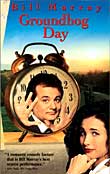 Harold Ramis' excellent existentialist romantic fantasy Groundhog Day
(1993) featured Bill Murray as an egotistical TV weatherman doomed
to experience deja vu and repeat the same day over and over again
(February 2, 1992) - beginning with a Sonny and Cher song - during the
Punxsutawney, Pennsylvania "Ground Hog Day" festivities. Ron Underwood's
enjoyable and funny City Slickers (1991) followed a group of suburbanized,
married, mid-life friends (including Billy Crystal as 40 year old Mitch
Robbins) on a two-week cattle drive led by Curly - a weathered and grizzly
trail boss (Best Supporting Actor Oscar-winning Jack Palance). Their experience
was repeated in the sequel City Slickers: The Legend of Curly's Gold
(1994) with virtually the same cast. Walter Matthau and Jack Lemmon
were brought together as two long-time feuding, cantankerous neighbors
who pursued the same woman in Grumpy Old Men (1993).
Harold Ramis' excellent existentialist romantic fantasy Groundhog Day
(1993) featured Bill Murray as an egotistical TV weatherman doomed
to experience deja vu and repeat the same day over and over again
(February 2, 1992) - beginning with a Sonny and Cher song - during the
Punxsutawney, Pennsylvania "Ground Hog Day" festivities. Ron Underwood's
enjoyable and funny City Slickers (1991) followed a group of suburbanized,
married, mid-life friends (including Billy Crystal as 40 year old Mitch
Robbins) on a two-week cattle drive led by Curly - a weathered and grizzly
trail boss (Best Supporting Actor Oscar-winning Jack Palance). Their experience
was repeated in the sequel City Slickers: The Legend of Curly's Gold
(1994) with virtually the same cast. Walter Matthau and Jack Lemmon
were brought together as two long-time feuding, cantankerous neighbors
who pursued the same woman in Grumpy Old Men (1993).
Tim Burton spoofed sci-fi alien-invasion and UFO films
of the 50s and 60s, Mystery Science Theater 3000, and even present day
films (i.e., Independence Day) with Mars Attacks! (1996), and he
saluted a 50's maverick, angora-wearing director-writer-producer (one
of the worst, but praised cult and B movie film-makers of all time) in
his black and white Ed Wood (1994), with Johnny Depp in the title
role and Best Supporting Actor Oscar-winner Martin Landau as horror star
and morphine addict Bela Lugosi. Robin Williams played a homeless tramp
(searching for the Holy Grail) and Jeff Bridges portrayed a shock-jock
who instigated a shooting tragedy in Terry Gilliam's fantasy comedy The
Fisher King (1991). Joe Pesci played a New York lawyer called to defend
an accused relative, but found himself out of his element in Alabama in
My Cousin Vinny (1992).
In Honeymoon in Vegas (1992), Nicolas Cage lost
his fiancee Sarah Jessica Parker to gambler James Caan in a bet and had
to travel to Hawaii and then back to the strip - where he parachuted down
as a sky-diving Elvis. In My Best Friend's Wedding (1997), Julia
Roberts (as Julianne Potter) realized she loved long-time friend Michael
(Dermot Mulroney), but he was due to marry Kimmy (Cameron Diaz) - so she
tried to break them up. And in another romantic comedy set in 1985, The
Wedding Singer (1998), Adam Sandler (as broken-hearted wedding singer
Robbie Hart) was left at the altar, while Drew Barrymore (as waitress
Julia Sullivan) was engaged to the wrong guy.
Woody Allen's Comedies:
In the 90s, writer-director-actor Woody Allen continued
to make mostly satirical, intelligent comedies, mostly set in New York.
Although he has shown signs of wear, with increasing bitterness and anger
reflected in his works (conceivably due to attacks by the tabloids and
the general public on his scandalous personal life), he remains a key
film-maker in the 90s and after:
- Alice (1990), originally titled The Magical
Herbs of Dr. Yang, about an angst-ridden, dissatisfied, hypochondriacal,
pampered and wealthy Manhattan housewife (Mia Farrow) and her spiritual
awakening (similar to the experiences of Alice in Wonderland)
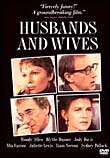 the
nightmarish, absurdist, and experimental Shadows and Fog (1992),
with Allen as a nebbish clerk enlisted to search for a serial killer;
with innumerable bit roles for Madonna, John Cusack, Donald Pleasence,
Kathy Bates, Jodie Foster, Lily Tomlin, Fred Gwynne, John Malkovich,
Kenneth Mars and more the
nightmarish, absurdist, and experimental Shadows and Fog (1992),
with Allen as a nebbish clerk enlisted to search for a serial killer;
with innumerable bit roles for Madonna, John Cusack, Donald Pleasence,
Kathy Bates, Jodie Foster, Lily Tomlin, Fred Gwynne, John Malkovich,
Kenneth Mars and more- the docudrama (in a mockumentary format)
Husbands and Wives (1992) - the engrossing, uncompromising, serious
examination of mid-life crises in two New York couples' marriages (Farrow
& Allen, and Sydney Pollack and Judy Davis); uncannily reflected
the director's highly-publicized, real-life problems and scandalous
conflict with Farrow after Allen admitted romantic involvement with
Farrow's adopted daughter (Soon-Yi Previn) in the winter of 1991
- Manhattan Murder Mystery (1993), reuniting
Diane Keaton and Allen as a Manhattanite, middle-class married
couple, similar to the detective duo of Nick and Nora Charles
in The
Thin Man (1934)
series and a semi-follow-up to their pairing in Annie
Hall (1977), the two suspected their next-door neighbor
of murdering his wife, in homage to Hitchcock's Rear
Window (1954); it also referenced Welles' The
Lady From Shanghai (1948), and Wilder's Double
Indemnity (1944)
- the backstage, Roaring 20s screwball comedy Bullets
Over Broadway (1994), without Allen as an actor, but with seven
Oscar nominations, involving a playwright (John Cusack), a Broadway
theatre diva star (Best Supporting Actress Oscar-winner Dianne Wiest,
with her third career nomination and second win), a mobster (Joe Viterelli)
and his hitman (Best Supporting Actor nominated Chazz Palminteri), and
the mobster's ditzy talentless, would-be actress-girlfriend (Best Supporting
Actress nominated Jennifer Tilly)
-
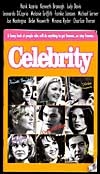 Mighty
Aphrodite (1995), Allen's 31st film with Best Supporting Actress
winner Mira Sorvino in a unique role as a naive, blonde prostitute/porno
actress named Linda Ash - the real mother of a Manhattan sportswriter's
(Allen) adopted young son; the film was presented as a Greek drama --
complete with a roaming chorus filmed in the Acropolis ruins Mighty
Aphrodite (1995), Allen's 31st film with Best Supporting Actress
winner Mira Sorvino in a unique role as a naive, blonde prostitute/porno
actress named Linda Ash - the real mother of a Manhattan sportswriter's
(Allen) adopted young son; the film was presented as a Greek drama --
complete with a roaming chorus filmed in the Acropolis ruins
- Deconstructing Harry (1997), a dark, caustic
comedy composed of flashbacks regarding Harry Block (Woody Allen), a
dysfunctional novelist; with this film, Allen received his 13th Best
Original Screenplay Oscar nomination
- Celebrity (1998), with cinematography by Swede
Sven Nykvist (Ingmar Bergman's most popular photographer), a New York
style treatise on fame and celebrity, starring Judy Davis, Kenneth Branagh,
Winona Ryder, Melanie Griffith, Joe Mantegna, Leonardo DiCaprio, Charlize
Theron, Famke Janssen, and others; resembled a dark version of Fellini's
La Dolce Vita (1960)
- Antz (1998), a computer-animated comedy-adventure
not directed or written by Woody Allen, but providing his voice
for Z, a misfit worker ant - a character similar to the neurotic protagonist
in Allen's comedies of the early 70s; it also had a villain named General
Mandible and a soldier named Weaver (voice of Sylvester Stallone)
- Sweet and Lowdown (1999), a Depression-Era,
semi-documentary portrait of Emmet Ray - a womanizing, guitar-playing
jazz musician (Best Actor-nominated Sean Penn) similar to Django Reinhardt,
and shy mute girlfriend (Best Supporting Actress-nominated Samantha
Morton)
 The Super-Stardom of Jim Carrey: The Super-Stardom of Jim Carrey:
Hammy and crude, face-twisting, clownish comedian Jim
Carrey, of Fox TV's comedy show In Living Color, began to make
a name for himself in Tom Shadyac's directorial debut film Ace Ventura:
Pet Detective (1993) as a low-cost, Florida missing-animals detective
searching for a kidnapped dolphin (the mascot for the Miami Dolphins football
team). His next two films propelled him into super-stardom - both were
from New Line Cinema (purchased by Ted Turner in 1993):
- Peter Farrelly's very low-brow physical comedy Dumb
and Dumber (1994) starred Jim Carrey and Jeff Daniels as Lloyd Christmas
and Harry Dunne (memorable in a hilarious bathroom scene) - two manic,
intellectually-challenged buddies on a cross-country road trip to Aspen,
Colorado to deliver a briefcase
 Chuck
Russell's adventure/fantasy/comedy The Mask (1994) combined gags
with great cartoonish digital effects when Carrey, as shy bank teller
Stanley Ipkiss, donned an ancient, magical mask and was transformed
into a green superhero; the film marked the debut of blonde actress
Cameron Diaz Chuck
Russell's adventure/fantasy/comedy The Mask (1994) combined gags
with great cartoonish digital effects when Carrey, as shy bank teller
Stanley Ipkiss, donned an ancient, magical mask and was transformed
into a green superhero; the film marked the debut of blonde actress
Cameron Diaz
The sequel Ace Ventura: When Nature Calls (1995)
suffered from a poor script and infantile-minded comedy. Carrey turned
to more legitimate acting at the end of the decade in two films.
In Peter Weir's comedy/drama The Truman Show (1998), Carrey
played the role of Truman Burbank, a happy suburbanite resident
of the paradisical fictional community of Seahaven Island, and
the unwitting, imprisoned star of a real-life documentary TV series
created and controlled
by god-like producer Christof (Ed Harris). And in Milos Forman's biopic Man
on the Moon (1999), he assumed the role of legendary comic Andy
Kaufman. In consecutive years, Carrey won the Golden Globe Best Actor
award for both roles, but was un-nominated for an Academy Award.
 Film History of the 1990s
Film History of the 1990s
Part 1, Part 2, Part 3, Part 4, Part 5, Part 6

 
|
